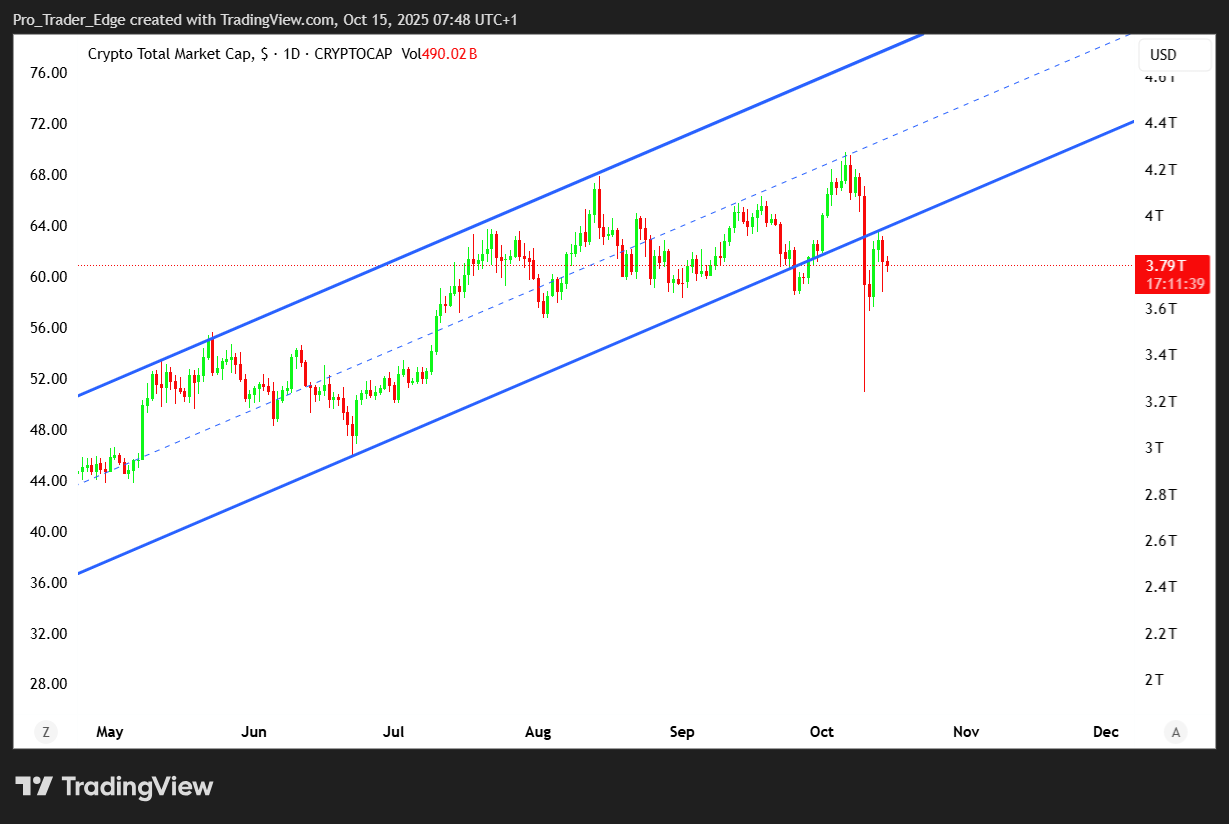TLDR
- Crypto markets recovered to $4 trillion market cap after the largest liquidation event ever recorded wiped out over $20 billion in leveraged positions
- Bitcoin stabilized near $112,700 while Ethereum traded around $4,101 following the weekend crash
- On-chain data shows whale accumulation accelerating with USDT supply increasing $15 billion in 60 days at the fastest pace since January
- U.S. spot Bitcoin ETF inflows reached $3.5 billion despite the volatility, showing institutional buyers remain active
- October historically delivers strong Bitcoin gains in the second half of the month, with analysts maintaining bullish outlook
The cryptocurrency market faced its largest liquidation event in history last weekend. More than $20 billion in leveraged trading positions were eliminated in hours. The crypto market cap quickly bounced back to $4 trillion despite the massive deleveraging.

Bitcoin stabilized around $112,700 after the initial crash. Ethereum declined 3.7% to approximately $4,101. The recovery speed surprised many market observers who expected prolonged weakness.
This liquidation event differed from previous crypto crashes. No external factors like regulatory crackdowns or exchange collapses triggered the sell-off. Analysts describe it as a structural market event driven purely by overleveraged positions.
Crypto podcaster Scott Melker said he expected deep losses for October. Instead, the market demonstrated resilience. He noted this wasn’t comparable to 2017’s ICOmania or 2021’s China mining ban.
Strong On-Chain Metrics Support Recovery
CryptoQuant data reveals continued whale accumulation throughout the liquidation event. Large Bitcoin holders increased their positions rather than selling. This pattern typically indicates confidence from sophisticated investors.
USDT supply expanded by nearly $15 billion over the past 60 days. This growth rate matches the fastest stablecoin expansion since January. Rising stablecoin supply often precedes buying pressure in crypto markets.
U.S. spot Bitcoin ETF products recorded $3.5 billion in net inflows. These institutional investment vehicles continue attracting capital despite market volatility. Glassnode reports that long-term capital remains within the crypto ecosystem.
The liquidation event cleared speculative excess from the market. Funding rates on perpetual futures contracts dropped by half. Options markets now price higher premiums for downside protection, reflecting more cautious positioning.
CryptoQuant analysts highlight $115,000 as a critical Bitcoin level. This price represents the on-chain realized cost basis for active traders. A sustained break above this threshold could trigger renewed bullish momentum.
October Seasonal Patterns Remain Intact
Bitcoin has gained during October in ten of the past twelve years. The cryptocurrency earned its “Uptober” nickname from this consistent performance. Bitcoin currently shows a minor 0.6% decline for the month.
Historical data shows the strongest October gains occur after mid-month. Bitcoin rallied 16% following October 15 in 2024. The 2023 October delivered a 29% gain in the second half of the month.
HashKey Group researcher Tim Sun expects continued near-term volatility. Market sentiment has not fully recovered from the aggressive deleveraging. Price action remains sensitive to news headlines and macroeconomic events.
Gold recently hit all-time highs before the crypto crash. Capital typically rotates from gold to Bitcoin following precious metal rallies. Investors appear to be reallocating portfolios rather than exiting risk assets entirely.
Trade tensions that contributed to the weekend sell-off are easing. U.S. President Trump and Chinese President Xi Jinping plan to meet for trade discussions. Analysts expect outcomes more moderate than current market concerns suggest.
Federal Reserve rate cut expectations support crypto market sentiment. The debasement trade narrative continues gaining traction among investors. Growing USDT supply indicates increasing fiat liquidity entering the crypto system.
Glassnode and CryptoQuant both conclude that structural demand remains healthy. While short-term traders were shaken out, long-term capital continues flowing into Bitcoin and crypto markets through multiple channels.


